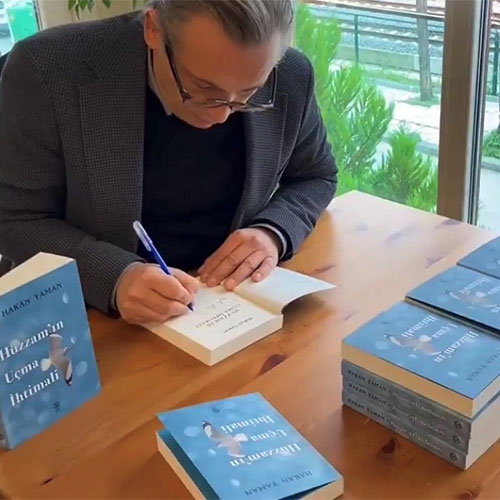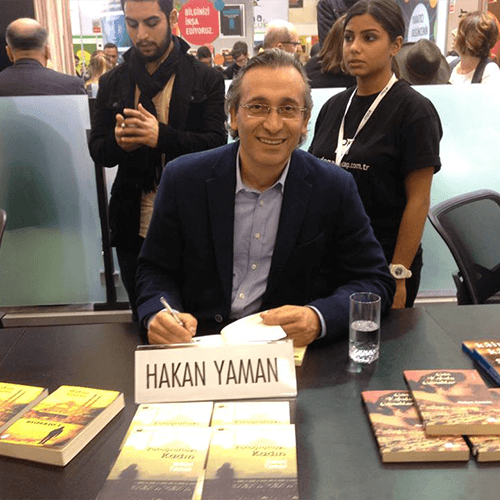THREE COUPS, THREE PERIODS:
1960 COUP, 12 MARCH COUP, 1980 COUP
Huzzam’s Possibility of Flying
In Hüzzam’s Possibility of Flying, Hakan Yaman weaves together in striking detail the events that shook the society, led to the arrest, torture and death of hundreds of people, the separation of families and the loss of lives; It introduces the world of young people, filled with unfulfilled loves and unfulfilled dreams. In the novel, which touches upon real people, from Turan Emeksiz to Deniz Gezmiş, from Talat Aydemir to Mahir Çayan, as well as imaginary heroes, these three chaotic periods create a painful backdrop with their ideals, destruction, and disappointments, to the novel of an Idealist elder brother’s Revolutionist younger brother İsa…
This striking novel, which Hakan Yaman wrote with an in-depth document study and what he heard from dozens of witnesses, is perhaps one of the most comprehensive works that deal with these periods fictionally.
THE WOMAN IN THE PHOTOGRAPH
“She suddenly passed by the door. At that very moment I realized that she would not only adorn my photograph but my life either. I pressed the shutter just like pulling the robe of a bird trap which I used set to trap goldfinch, serinus or greenfinch birds as I was a kid. My heart was beating loudly. I was breathless. At that very moment, time slowed down like it used to be in the past. My dwarf life resembling to the extinguished stars was filled with a light and firstly I, and then everybody, everywhere, the whole Istanbul was evaporated. Everything, living or lifeless that are spinning around with everchanging images right in front of me were disappeared. All my obsessed visions faded away for a while and the time was frozen. She was so beautiful. She walked down the alley disregarding the warm evening wind, dispersing her long, black hair and she disappeared by silently shrinking. Ever before had I been so deeply charmed and mesmerized by a woman. I tagged along her in haste as I came to my senses. My neck, my face and my ears were blushed. I felt it. My heart which could hardly pump blood to my heavy body was excitedly beating…”
Hakan Yaman’s 2009 Yunus Nadi Novel Prize winning novel The Woman in the Photograph is the novel of a passionate love. Suphi, the protagonist of the novel is an amateur photographer who lives in solitude in his own little world. But his colourless life changes as he takes the photograph of a beautiful woman who he runs across by coincidence. Suphi runs after that glimpsing image but she can’t find the woman. After a while, this pursuit and the woman becomes an obsession. Suphi’s persistent quests end with an astonishing final.
THE WINGS OF ISRAFEL
“Even though it is so pale, there is a four winged angel that I see with my old eyes here. He resembles Israfel. Portrayal of Israfel is used on some talismans. For instance, there is a relief of Israfel which resembles this one a lot on one of the four pillars in Saint Sophia Church. There are the portrayals of Michael, Gabriel, Azrael on other pillars. Each of these four angels cause miracles and disasters. The wings of Israfel is the sign of a great famine which will start in West… Angels are commonly pictured with two wings, but angel Israfel who will blow the trumpet called Sûr on the Day of Judgment has four wings. Israfel holds the West with one of his four wings and the East with the other one; he descends from the heavens to the earth with the third wing and covers himself to be concealed with his last wing. The gate of the new world will open with his fourth blow on the last day and this will be the actual beginning.”
In mid 1900s, four university students who are in pursuit of an anonym, mysterious lost book in a nook corner of Istanbul and the same book that rules people’s fates by passing from hand to hand in 1700s, during the reign of Sultan Mahmud I. In pursuit of a book that is written in all alphabets, read from four directions, contains all the secrets of the universe. A mysterious book with 444 pages that is chased from the dark galleries of old Cairo to the alleys of the Ottoman Istanbul, from the vessel of a rich Marseilles book collector to the turbulent 50s of Turkey and a very layered story…
SILENCE OF THE BIRCH TREES
If your life had changed out of the blue, would you go away leaving everything, your house and even your loved ones behind without hesitation for the sake of your dreams and your freedom?
Macide is a music teacher who leads a quiet life together with his husband Salim and with his son in a province. She suddenly disappears without notice and a trace in a morning. Her husband’s and son’s lives take an utterly different path with her disappearance. Salim starts searching for his wife worrying about her life in the beginning, but in time he starts having doubts about her and this new state of freedom opens new gates for him. And Macide takes a different route with a good reason which she doesn’t tell anyone.
Hakan Yaman makes us interrogate whether it is possible to restart our lives one more time as we are on a lost woman’s trail. An extensive and thought-provoking novel about the priorities in human relations and about our lives by the writer of Woman in the Photograph which was granted the Yunus Nadi Novel Award.
FALL SCENTED SINS
Now a sullener light fell over the bay. It looked just like the troubled light he had seen in one of Zonaro’s paintings. Alfredo suddenly thought that when he saw that light in the painting, he did not find it so gloomy. In fact, it was not the light itself that was muggy, it was our mood that gave meaning to everything around us. At that moment, someone sitting with friends on the terrace of another house nearby, sipping a drink with pleasure, might well have found the same light fascinating, inspiring, and even very romantic.
Believing that the difficult years of his life are over and peaceful days are approaching, the great merchant Alfredo is heartbroken when he reads the travel diary written by his beautiful wife during a trip they went on years ago, and he tries to determine to whom the bullet of his wrath and revenge will be directed, among his best friend, his wife, and himself. The relationships full of love, jealousy, betrayal, and revenge between the Levantines of Izmir towards the end of the 19th century are slowly revealed between the lines of a tour in the ancient cities of the Aegean in Hakan Yaman’s novel, Fall Scented Sins.
Speak up, say something. Swell the seas, break out storms, create earthquakes, destroy this city, sink it like Sodom and Gomorrah… Sink it… Sink it so that we can all be purified from our sins in the salty waters of the Aegean Sea. Sink it!
THE NOVELIST
The protagonist of The Novelist is a loser who has a disappointment both in life and in authorship. In his last novel, he is telling us how he came on the verge of suicide. He does the best thing he can and starts writing a suicide novel instead of leaving a short suicide note behind.
Our novelist protagonist confesses that he committed a double murder just in the beginning of his novel. While the police is seeking him, we are reading the last novel he is writing. Through the novel we are taking literal strolls in the old quarters of Istanbul, we are walking around the parks with his sister and her dog, we are going into dark bars in Beyoglu, we meet the novelist’s veiled girlfriend Zahide, his sister with Down syndrome, his retired journalist father.
While he is telling us the chain of events, driving him to commit murders with patient and fictional narrative, he is slowly taking us back to his victims and to the moment of murders. Literature never leaves us alone through our strolling.
The novel Hakan Yaman wrote a short time before Gezi Park protests contains socioeconomic turmoil, political dilemma, abuse of religion, secular anti-secular conflicts in Turkey. It is an astonishing crime fiction of Istanbul.
Interviews & Reviews


KİTAPLAR
Doğan Hızlan, Hakan Yaman için, yarattığı karakterler aracılığıyla eski İstanbul semtlerinin ve oradaki yaşayışın tablosunu çizdi, diyor.
Hakan Yaman, içinde kâinatın tüm sırlarının saklı olduğu düşünülen esrarengiz bir kitabın, Türkiye’nin çalkantılı 50’li yıllarıyla 1700’lerde, Sultan I. Mahmud dönemi arasında gidip gelen hikâyesi üzerinden din, mezhep ve etnik ayrımcılık gibi önemli sorunlara yer verdiği ilk romanı İsrafil’in Kanatları ile kendisine 2008 Yunus Nadi Roman Ödülü’nü kazandıran Fotoğraftaki Kadın ve Çifte cinayetten aranan bir romancının intihar notu olarak yazdığı son romanını konu alan Romancı romanının mekânı olarak da İstanbul’u seçti. İstanbul’un tarihi mekânları, kuytuda kalmış, unutulmuş köşeleri onun romanlarında yeniden canlandı. Ancak zaman ve mekân ne olursa olsun romanlarında hep insanın derinliklerine inmeyi, insanı anlamayı ve anlatmayı denedi.






